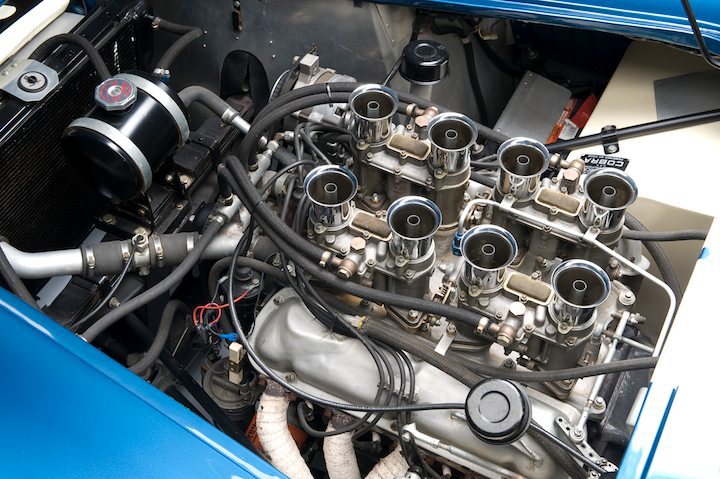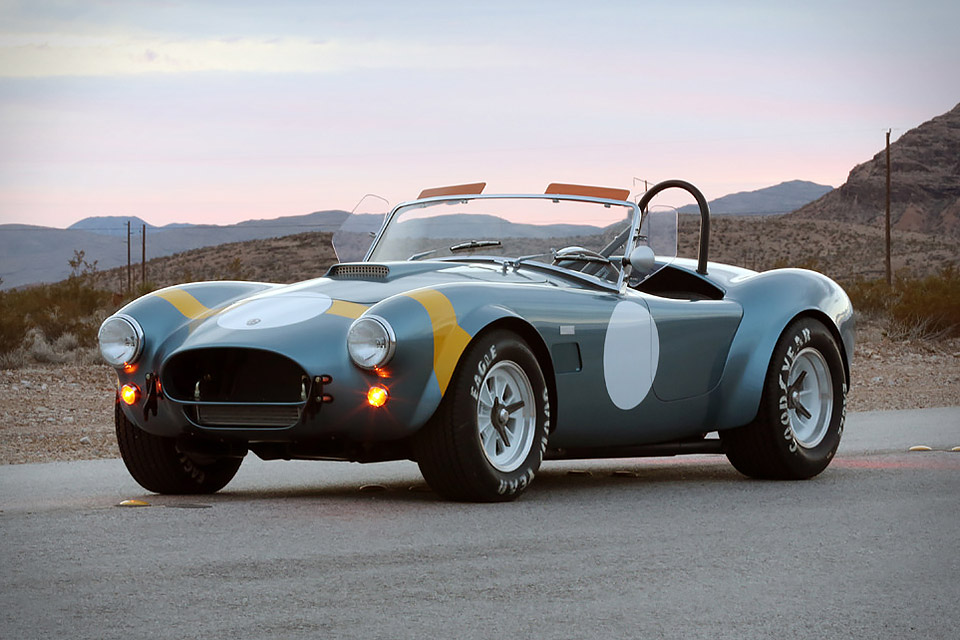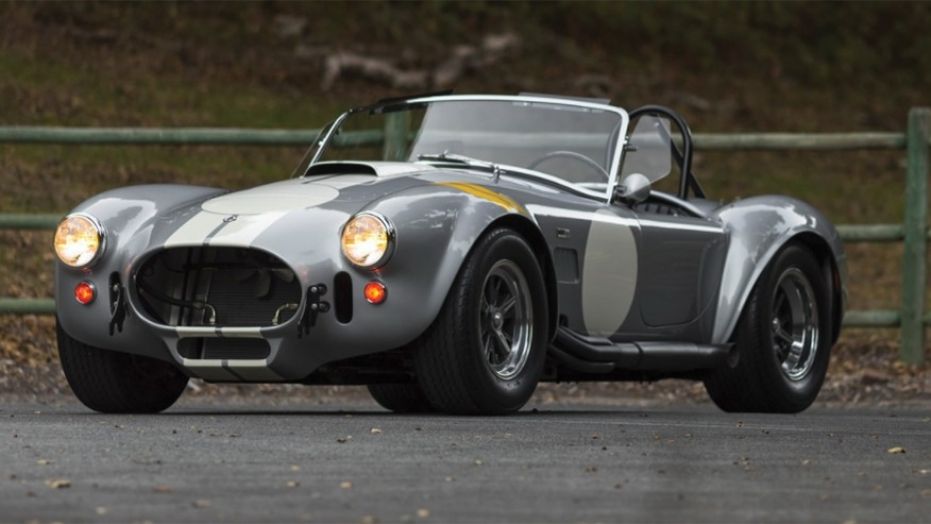Carroll Shelby's AC Cobras |

|
Carroll Shelby . . . the
name instantly conjures up images of high performance cars and pure bred
racing machines. One of the many undertakings that brought fame to the
"East Texas chicken farmer," was the Cobra. The Cobra was a
quick, nimble, rocket on wheels, which was exactly what Shelby had in
mind when he decided to build the world’s fastest production car.
In the early sixties, Carroll
Shelby was told by his doctor to stop racing because of a bad heart. It
was at that time that he decided to take on one his long time dreams of
building his own breed of car, one with European styling and American
power.
As it turns out, it couldn’t have happened at a better time. Ford
Motor Company had been playing with ideas of getting into the performance
arena. When Shelby contacted them and told them of his idea of building
a Ford powered sports car, they had no idea that they were about to embark
upon a journey that would bring them into international prominence in
every area of the racing world.
In 1961, Shelby heard from a journalist
friend that AC Cars, a British auto manufacturer, was about to lose their
supply of Bristol six cylinder engines. The Bristol engine in the lightweight
AC Ace made for an almost unbeatable combination in SCCA competition.
Shelby borrowed an Ace to get a closer look. He liked what he saw! The
car definitely had the potential that Shelby was looking for. At about
the same time, Shelby started hearing about a new lightweight V-8 engine
that Ford was starting to produce. Shelby wrote to Dave Evans with Ford
Motor Co. to verify that the new engine was a reality and to tell them
about his idea of a Ford powered AC Ace. Evans must have liked what he
read, because as soon as he finished reading the letter, he phoned Shelby
to say that he was sending him two of the new engines.
During this same
period, Shelby had been talking with people at AC Cars, Ltd. about a new
engine for their Ace. They agreed to send Shelby an Ace to build his first
prototype with. Shelby’s dream was on its way to becoming a reality. A
few weeks later, the first AC "Cobra" was delivered, engineless, to the
Los Angeles airport. A mere eight hours after being unloaded, the first
Cobra roared to life. Everyone, including Shelby, knew that this was only
the first step and that the Cobra had a long way to go. Shelby knew instantly
that this was the car he had been dreaming about.
|
Evolution
of the AC Cobra
Chronology of the AC Cobra
|
| October 1953 |
AC Ace was unveiled at Earls Court Motor Show in London |
| 1956 |
Ace became available with the Bristol six cylinder engine |
| 1958 |
Ford lightweight small block V-8 engine program started
in the USA |
| December 1960 |
Carroll Shelby raced for the last time at Riverside |
| March 1961 |
British Ford six cylinder engine was used in the Ace when
Bristol switched to the Chrysler V8 |
| September 1961 |
Carroll Shelby contacted AC about his ideas for a V8 engine
sports car based on the AC Ace |
| November 1961 |
The first lightweight Ford V8's were delivered to AC |
| 1961-1962 |
AC and Shelby worked on the first Cobra prototype |
| January 1962 |
Prototype Cobra runs for the first time at #4d4d4dstone |
| February 1962 |
CSX2000 - The 221 cid engine was removed and the car was
shipped to Shelby in Santa Fe Springs where it was fitted with
a 260 cid engine and tested at Riverside |
| April 1962 |
The Cobra was introduced to the press and first shown in
public at the New York Auto Show |
| May 1962 |
First magazine road test of the prototype Cobra appeared |
| July 1962 |
The first three "production" Cobras were completed and
shipped to the USA complete with 260 cid engines |
| October 1962 |
The first Cobra was raced for the first time, by Billy
Krause at Riverside |
| January 1963 |
CSX2075 - First 289 cid powered Cobra was completed |
| January 1963 |
Cobra's first race win was at Riverside |
| March 1963 |
CSX2127 - First production rack and pinion Cobra was completed |
| June 1963 |
Two Cobras entered at Le Mans; one retired and the other
finished seventh overall |
| Late 1963 |
AC Ace production stopped |
| October 1963 |
The first 427 cid powered prototype was built using a leaf
spring chassis |
| November 1963 |
The first right hand drive Cobra was delivered in the UK |
| November 1963 |
Work began on a Cobra racing coupe which was to become
the Daytona Coupe |
| February 1964 |
CSX2287 - The first Daytona Coupe was tested at Riverside.
During 1964 it took three GT class wins and placed fourth overall
at Le Mans |
| March 1964 |
CSX2166 - Ken Miles raced a prototype 427, leaf spring
chassis, at Sebring |
| April 1964 |
AC tested its own 289 cid coupe at Le Mans |
| November 1964 |
Leaf spring chassis production for export was stopped |
| December 1964 |
CSX2196 - second 427 cid prototype was debuted by Ken Miles
at Nassau Speed Weeks |
| January 1965 |
CSX3001 - Production of completely redesigned, coil spring
427 Cobra was announced |
| Early 1965 |
CSX3054 - 427 Super Coupe project was started but eventually
abandoned |
| March 1965 |
Leaf spring chassis production stopped completely after
655 cars were built |
| 1965 |
Daytona Coupe won the World Manufacturer's Championship
for GT cars with six GT class wins |
| May 1966 |
AC started producing 289 powered versions of the coil spring
chassis for the European market |
| February 1968 |
Five special "long wheelbase" chassis were built for Paramount
Pictures film |
| February 1969 |
Final coil spring car completed in the European series
after a total of 348 were built |

| AC Cobra
- 289 Specs |
| 1962-1965 Production |
| Body Type |
Two seat roadster - all aluminium |
| Chassis |
Twin tube ladder frame w/ box section suspension mountings
and tubular structure |
| Engine Type |
Ford V8 |
| Displacement |
289 cid (4,736 cc) (260 cid up to chassis CSX2074) |
| Bore |
4.0 in (101.6 mm); 3.80 in (96.5 mm) |
| Stroke |
2.87 in (72.9 mm) |
| Compression Ratio |
11.6:1 |
| Cylinder Type |
Thinwall cast iron block, five main bearings, single camshaft |
| Cylinder Heads |
Cast iron, two valves per cylinder |
| Fuel System |
Single four-barrel Holley carburetor or four two barrel
downdraft Weber carburetors |
| Horsepower |
271 bhp @ 6,000 rpm (260 bhp @ 5,800 rpm w/ 260 cid) |
| Torque |
314 lb ft @ 3,400 rpm (269 lb ft @ 4,800 rpm w/ 260 cid) |
| Gearbox Type |
Borg-Warner four speed manual, all synchromesh |
| Gear Ratios |
First: 2.36:1, Second: 1.78:1, Third: 1.41:1, Fourth: 1.0:1,
Reverse: 2.36:1 |
| Final Drive Ratio |
3.77:1 (numerous options available) |
| Clutch |
Single dry plate, hydraulic operation |
| Front Suspension |
Independent, w/ lower wishbone and transverse leafspring
upper link, telescopic dampers |
| Rear Suspension |
Independent, w/ lower wishbone and transverse leafspring
upper link, telescopic dampers |
| Brakes |
Solid discs, front and rear |
| Steering |
Rack and pinion (worm and sector up to chassis CSX2125) |
| Overall length |
151.5 in (3,848 mm) |
| Overall width |
61.0 in (1,549 mm) |
| Overall height |
49.0 in (1,244 mm) |
| Wheelbase |
90.0 in (2,286 mm) |
| Track |
Front: 51.5 in (1,308 mm) Rear: 52.5 in (1,333 mm) |
| Ground Clearance |
5.0 in (127 mm) |
| Fuel Tank Capacity |
18.0 US gallons (68 litres) |
| Unladen Weight |
2,170 lb (984 kg) |
| Performance (Typical
Figures for 289) |
| Top Speed |
138 mph (222 kph) |
| 0-60 mph (0-96.5 kph) |
5.5 seconds |
| 0-100 mph (0-161 kph) |
13.0 seconds |
| Standing 1/4-mile |
13.9 seconds |
| Fuel Consumption |
15.1 mpg |

| AC Cobra
- 427 Specs |
| 1965-1968 Production |
| Body Type |
Two seat roadster - all aluminium |
| Chassis |
Large diameter twin tube ladder frame w/ tubular suspension
mountings and tubular structure |
| Engine Type |
Ford V8 |
| Displacement |
427 cid (6,984 cc); 428 (6,991 cc) (both engines were
used in the 427 Cobra) |
| Bore |
4.24 in (107.7 mm); 4.13 in (104.9 mm) |
| Stroke |
3.87 in (96.0 mm); 3.98 in (101.1 mm) |
| Compression Ratio |
10.4:1; 10.5:1 |
| Cylinder Type |
Cast iron block, five main bearings, single camshaft |
| Cylinder Heads |
Cast iron, two valves per cylinder |
| Fuel System |
Single four-barrel Holley carburetor or four two barrel
downdraft Weber carburetors |
| Horsepower |
425 bhp @ 6,500 rpm; 390 bhp @ 5,200 rpm |
| Torque |
480 lb ft @ 3,500 rpm; 475 lb ft @ 3,700 rpm w/ 260 cid) |
| Gearbox Type |
Ford "top loader" four speed manual, all synchromesh |
| Gear Ratios |
First: 2.32:1, Second: 1.69:1, Third: 1.29:1, Fourth:
1.0:1, Reverse: 2.32:1 |
| Final Drive Ratio |
3.31:1 (numerous options available) |
| Clutch |
Single dry plate, hydraulic operation |
| Front Suspension |
Independent, unequal length upper and lower wishbones,
coil springs, telescopic dampers |
| Rear Suspension |
Independent, unequal length upper and lower wishbones
with additional lower trailing links, coil springs, telescopic
dampers |
| Brakes |
Solid discs, front and rear |
| Steering |
Rack and pinion |
| Overall Length |
156.0 in (3,962 mm) |
| Overall Width |
68.0 in (1,727 mm) |
| Overall Height |
49.0 in (1,244 mm) |
| Wheelbase |
90.0 in (2,286 mm) |
| Track |
Front: 56.0 in (1,422 mm) Rear: 56.0 in (1,422 mm) |
| Ground Clearance |
4.5 in (114 mm) |
| Fuel Tank Capacity |
18.0 US gallons (68 litres) |
| Unladen Weight |
2,350 lb (1,066 kg) |
| Performance
(Typical Figures for 427) |
| Top Speed |
165 mph (265 kph) |
| 0-60 mph (0-96.5 kph) |
4.2 seconds |
| 0-100 mph (0-161 kph) |
10.3 seconds |
| Standing 1/4-mile |
12.4 seconds |
| Fuel Consumption |
10.0 mpg |
Copyright © 2019 Class 1 Classic Cars, LLC. All Rights Reserved
|



